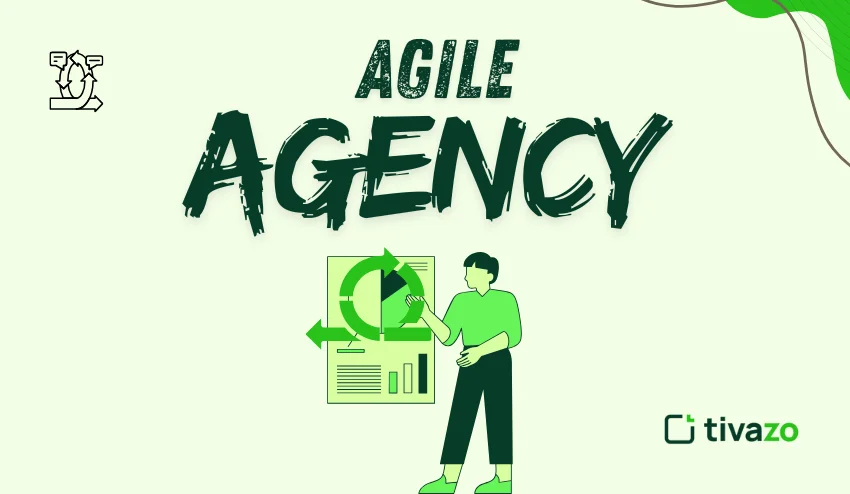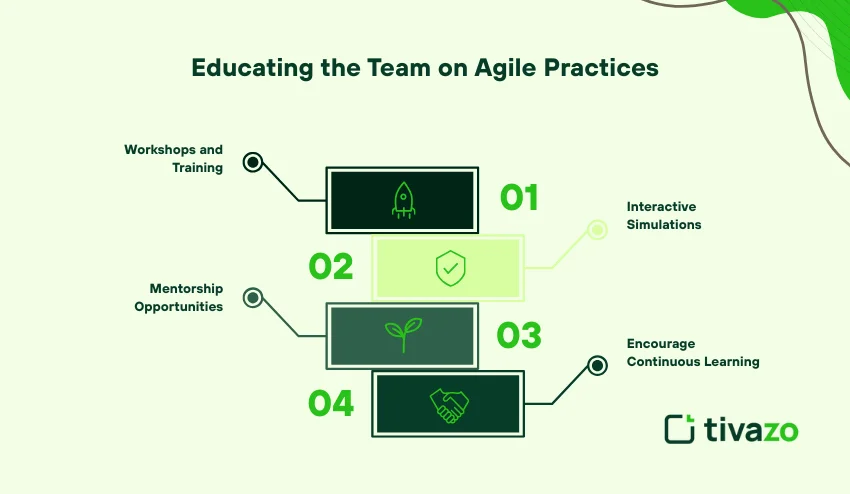In today’s fast-moving business environment, companies are always looking for ways to remain competitive, deliver faster, and respond to market change. One of the solutions that is getting lots of excitement is the agile agency concept.
This guide will explore the agile agency, how agile methodology works, what agile practices look like, and how to begin cooperative steps toward these methods that can be put in practice within your organization.
What is an Agile Agency?
An agile agency is a company that applies antifragile principles to project management, collaboration, and client outcomes. Unlike the traditional agency with its crazy hierarchical layers with slow decision-making, the agile agency focuses more on agility, speed of iteration, and incremental delivery.

Here are examples of key features of an agile agency:
- Cross-functional teams are collaboratively organized and self-directed
- Client feedback is processed and responded into action with a high degree of speed
- Projects are expected to go through iterative development and can be changed or pivoted
New trials and experiments are regularly added for continuous improvement. Constructive feedback is encouraged, with no consideration of workloads
There is clarity and a notion of accountability, not only considering work, but also client feedback, and ultimately how work is produced and with whom.
An agile agency is fundamentally not about processes, but rather a mindset for teams to learn, adapt, and innovate.
Grasping Agile Methodology
Agile methodology is the cornerstone of agile agency. It refers to a project management methodology founded on:
- Flexibility
- Collaboration
- Iterative growth
- Client feedback
With agile methodology, teams can adjust to changing requirements, prioritize work, and deliver value more frequently using smaller increments of work. Frequent review of progress and feedback reduces mistakes, improves quality, and ensures the team stays on the same page as regards the client’s expectations. This type of approach builds transparency and accountability while fostering a culture of continuous improvement that works well with evolving projects in fast-paced environments.

The Essential Principles of Agile Methodology
- People and interactions over processes and tools
- Working solution over comprehensive documentation
- Customer collaboration over negotiation
- Responding to change by following a plan
These principles prepare agencies to work quickly, increase quality, and usually set them up to stay on the same page as their clients expect. Agile method reinforces teamwork and adaptation by revolving around people and communication.
Working solution is important because it provides the client with a tangible and worthwhile effort to quickly experience, and a degree of flexibility, being open to changes along the way will help the teams be agile while placing their focus where needed, around changing needs. This type of mindset strengthens innovation and reduces wasted effort, while most significantly improving and developing a long-term relationship with clients.
Example of the Agile Methodology
Let’s look at an example of how an agile agency operates:
| Step | Description | Agile Principle Applied |
| Sprint Planning | Define tasks for 2-week sprint | Iterative development |
| Daily Standup | 15-minute team updates | Collaboration & communication |
| Collaboration & communication | Client Review Present work for feedbac | Customer collaboration |
| Sprint Retrospective | Reflect on what worked & improve | Continuous improvement |
In this example, the agency gives value in small chunks, reduces risks, and reacts quickly – all important traits for a successful agile agency. The project work is broken down into manageable sprints. The team can work quickly and be honest about what the problems are and any time it is necessary to pivot to meet the client expectations. When you use the agile methodology, the group becomes a stronger team, everyone is accountable, and the team is always moving toward project goals.
Embracing Agile Practices
Moving to an agile agency does not occur overnight and will require thoughtful planning and execution effort. This transition is more than just an operational process-it’s a shift in culture that will require everyone from senior leadership to team members to consider a different way of working. Successfully adopting agile practices can significantly improve organizational efficiencies, collaboration, and outcomes for clients, and therefore it’s worth the effort to make a transition.
1. Evaluate Existing Processes
Make note of where your team encounters bottlenecks or delayed response time. Take the time to draw an outline of workflows, analyze where and how tasks are handed off, and take a look at where the communication breaks down. Knowing where your pain points are will allow you to have a place to start improving. Evaluating your processes in detail will allow you to intelligently prioritize changes to make sure agile practices are in place to tackle the issues encountered rather than to implement a solution that suggests a better way to work but does not necessarily address pain points.
2. Establish Goal and Metrics
Set measurable goals for efficiencies, client satisfaction and innovation. You must define what success looks like in your agency: does that mean finishing project faster, doing work of higher quality, better collaboration on teams? The team or organization also needs to have measurable goals to track if they’re improving over time. More concrete are key performance indicators (KPIs) that serve as benchmarks to help track agency progression over time. When there are clear goals and measurable units for those goals accountability happens and if the goals are in place it gives the team a target to strive for in the agile transition process.
3.Train Your Team on Agile Practices
Train your staff in Agile principles, frameworks (e.g. Scrum or Kanban), and in collaborative tools to use. Provide them with hands-on workshops, online courses, and mentoring programs, so that team members can understand how to employ Agile principles in their work. When you provide training, it will help grow proficiency in your teams, reduce resistance to change, and equip teams to effectively manage iterative workflows so your organization adopts organizational practices with success and sustainability.
4. Implement Iterative Workflows
Train your staff in Agile principles, frameworks (e.g. Scrum or Kanban), and in collaborative tools to use. Provide them with hands-on workshops, online courses, and mentoring programs, so that team members can understand how to employ Agile principles in their work. When you provide training, it will help grow proficiency in your teams, reduce resistance to change, and equip teams to effectively manage iterative workflows so your organization adopts organizational practices with success and sustainability.
5. Implement Iterative Workflows
Begin implementing your work with small projects, applying sprints, stand-ups, and retrospective meetings. Consider breaking projects into smaller parts so teams can experiment with Agile practices in a less risky space, adapting and modifying in real time, based on lessons learned. Iteration encourages continuous improvement; collaboration and transparency; responsibility and accountability to team goals; and adaption by teams to the needs of the networked social system they are working in.

Gather Feedback and Refine
Take the time to continuously assess performance and to derive improvements based on this data. Solicit feedback regularly and synthesize input from the team and clients to identify obstacles, issues, and opportunities for improvement. Use performance measures to make decisions, modify processes, or identify appropriate practices. A feedback-oriented philosophy ensures that the agency will become an organization able to innovate, optimize, and respond to the needs of clients. They would become an agile organization.
By taking these steps, any agency can begin moving towards being an agile agency. One effect on project outcomes will be improved. The other benefit will be fostering a culture of collaboration, dependability, and continuing education to create an agile agency that can navigate today’s rapidly changing business environment.
Obstacles of Transitioning to Agile
Although transitioning to agile practices has many benefits, many agencies encounter some obstacles such as:
| Challenge | Solution |
| Resistance to Change | Conduct Workshops to continue building awareness |
| Lacking Agile Knowledge | Provide Training and Mentorship |
| Overlapping Responsibilities | Defining Roles and Accountability |
| Difficulty in Measure ROI | Defining KPI’s and Measure Metrics |
Be aware of these aboard transitions to proactively mitigate risks associated with these challenges.
Educating the Team on Agile Practices
Education is a key component of becoming an Agile agency. Some mechanisms to use in educating your agency around agile are:
- Workshops and Training– Basic introduction to industry concepts and frameworks
- Mentorship Opportunities– Foster relationships to experienced agile practitioners to guide the team.
- Interactive Simulations– Practice conducting sprints, stand-ups, and retrospectives in an environment that feels safe.
- Encourage Continuous Learning– Encourage and support team members in seeking outside certifications and online courses.
An educated team is the foundation of a successful agile agency.

Upsides of Becoming An Agile Agency
The advantages of becoming an agile agency are many, such as:
- Faster delivery of projects.
- Greater client satisfaction.
- Better team collaboration.
- Greater flexability to continue changes in the marketplace.
- Greater innovation and creativety.
These advantages are worthy of exploring as opposed to just the “next” agile phase of some agencies in a competitive market place.
Conclusion
An agile agency employs the agile framework to streamline project development, rapidly adapt, and produce improved outcomes. By focusing on flexibility, collaboration, iterative development, and customer feedback, agile agencies are also able to deliver results faster and with greater quality than non-agile agency models. To transition to an agile agency model, organizations will need to carry out a few key steps, such as assessing existing processes, establishing shared objectives, training staff on agile practices, implementing iterative cycles of work, and collecting feedback for continuous improvement.
While challenges to creating an agile agency exist, such as resistance to change, proper education, metrics, and tools, can ease the transition. Utilizing agile practices develops productivity, creativity, and client satisfaction, coupled with a culture of continuous improvement which should be embraced by any modern agency.
🚀 Ready to Transform Your Business with an Agile Agency?
Start adopting agile strategies today and unlock faster delivery, better collaboration, and higher client satisfaction.
Take the first step toward becoming a truly agile agency!




